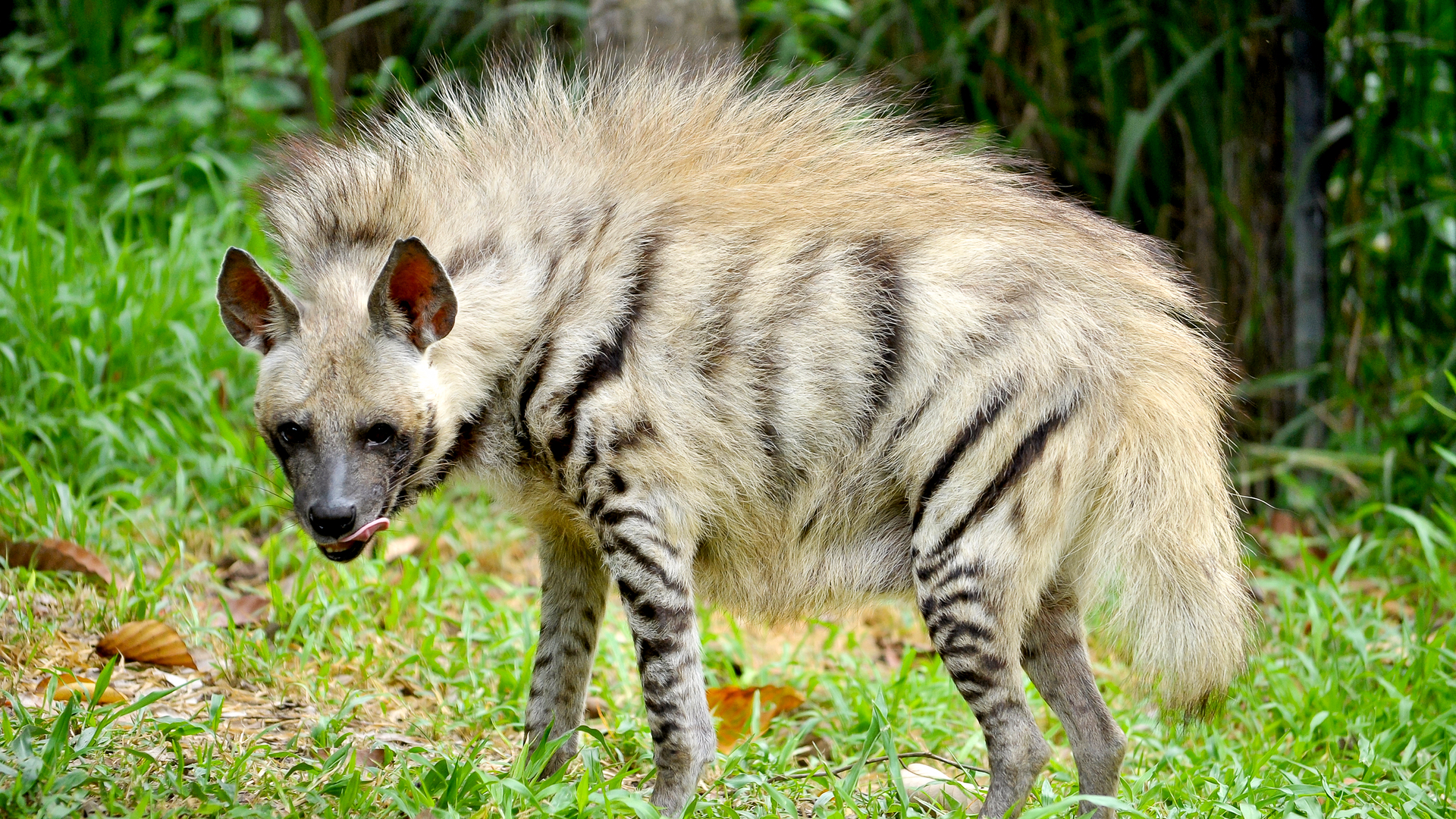- Home
- Conservancy
- Striped hyaena
Description
The striped hyena has a fairly massive, but short torso set on long legs. The hind legs are significantly shorter than the forelimbs, thus causing the back to slope downwards. The legs are relatively thin and weak, with the forelegs being bent at the carpal region. The neck is thick, long and largely immobile, while the head is heavy and massive with a shortened facial region. The eyes are small, while the sharply pointed ears are very large, broad and set high on the head. Like all hyenas, the striped hyena has bulky pads on its paws, as well as blunt but powerful claws. The tail is short and the terminal hairs do not descend below the achilles tendon.
The striped hyena lacks the enlarged clitoris and false scrotal sack noted in the female genitalia of the spotted hyena. The female has 3 pairs of nipples. Adult weight can range from 22 to 55 kg (49 to 121 lb), averaging at about 35 kg (77 lb). Body length can range from 85 to 130 cm (33 to 51 in), not counting a tail of 25 to 40 cm (9.8 to 15.7 in), and shoulder height is between 60–80 cm (24–31 in). The male has a large pouch of naked skin located at the anal opening. Large anal glands open into it from above the anus. Several sebaceous glands are present between the openings of the anal glands and above them. The anus can be everted up to a length of 5 cm, and is everted during social interaction and mating. When attacked, the striped hyena everts its rectum and sprays a pungent smelling liquid from its anal glands. Its eyesight is acute, though its senses of smell and hearing are weak.
The skull is entirely typical of the genus, having a very high sagittal crest, a shortened facial region and an inflated frontal bone. The skull of the striped hyena differs from that of the brown and spotted hyena by its smaller size and slightly less massive build. It is nonetheless still powerfully structured and well adapted to anchoring exceptionally strong jaw musc which give it enough bite-force to splinter a camel's thigh bone. Although the dentition is overall smaller than that of the spotted hyena, the upper molar of the striped hyena is far larger
Fun Facts
The striped hyena is a primarily nocturnal animal, which typically only leaves its den at the onset of total darkness, returning before sunrise. Striped hyenas typically live in groups of 1–2 animals, though groups of up to seven animals are known in Libya. They are generally not territorial animals, with home ranges of different groups often overlapping each other. Home ranges in the Serengheti have been recorded to be 44 km2 (17 sq mi)-72 km2 (28 sq mi), while one in the Negev was calculated at 61 km2 (24 sq mi).
When marking their territory, striped hyenas use the paste of their anal pouch (hyena butter) to scent mark grass, stalks, stones, tree trunks and other objects. In aggressive encounters, the black patch near the thoracic and lumbar vertebrae is erected. When fighting, striped hyenas will bite at the throat and legs, but avoid the mane, which serves as a signalling device. When greeting each other, they lick the mid-back region, sniff each other's noses, extrude their anal pouch or paw each other's throats.The species is not as vocal as the spotted hyena, its vocalisations being limited to a chattering laugh and howling.
Reproduction and development
The striped hyena is monogamous, with the male helping the female to establish a den, raise young and feed her when cubs are born. The mating season varies according to location; in Transcaucasia, hyenas breed in January–February, while those in southeast Turkmenia breed in October–November. In captivity, breeding is non-seasonal. Mating can occur at any time of the day, during which the male grips the skin of the female's neck.
The gestation period lasts 90–91 days. Striped hyena cubs are born with adult markings, closed eyes and small ears. This is in marked contrast to newborn spotted hyena cubs which are born almost fully developed, though with black, unmarked coats. Their eyes open after 7–8 days, and the cubs leave their dens after one month. Cubs are weaned at the age of 2 months, and are then fed by both parents. Despite the males' assistance, female hyenas are very protective of their cubs, and will chase their mates away from the cubs if they approach too closely. By autumn, the cubs are half the size of their parents. In the wild, striped hyenas can live for 12 years, while in captivity they have been known to reach.
Burrowing behaviours
The striped hyena may dig its own dens, but it also establishes its lairs in caves, rock fissures, erosion channels and burrows formerly occupied by porcupines, wolves, warthogs and aardvarks. Hyena dens can be identified by the presence of bones at their entrances. The striped hyena hides in caves, niches, pits, dense thickets, reeds and plume grass during the day to shelter from predators, heat or winter cold. The size and elaboration of striped hyena dens varies according to location ; dens in the Karakum have entrances 0.67–0.72 m wide and are extended over a distance of 4.15–5 m, with no lateral extensions or special chambers. In contrast, hyena dens in Israel are much more elaborate and large, exceeding 27 m in length
